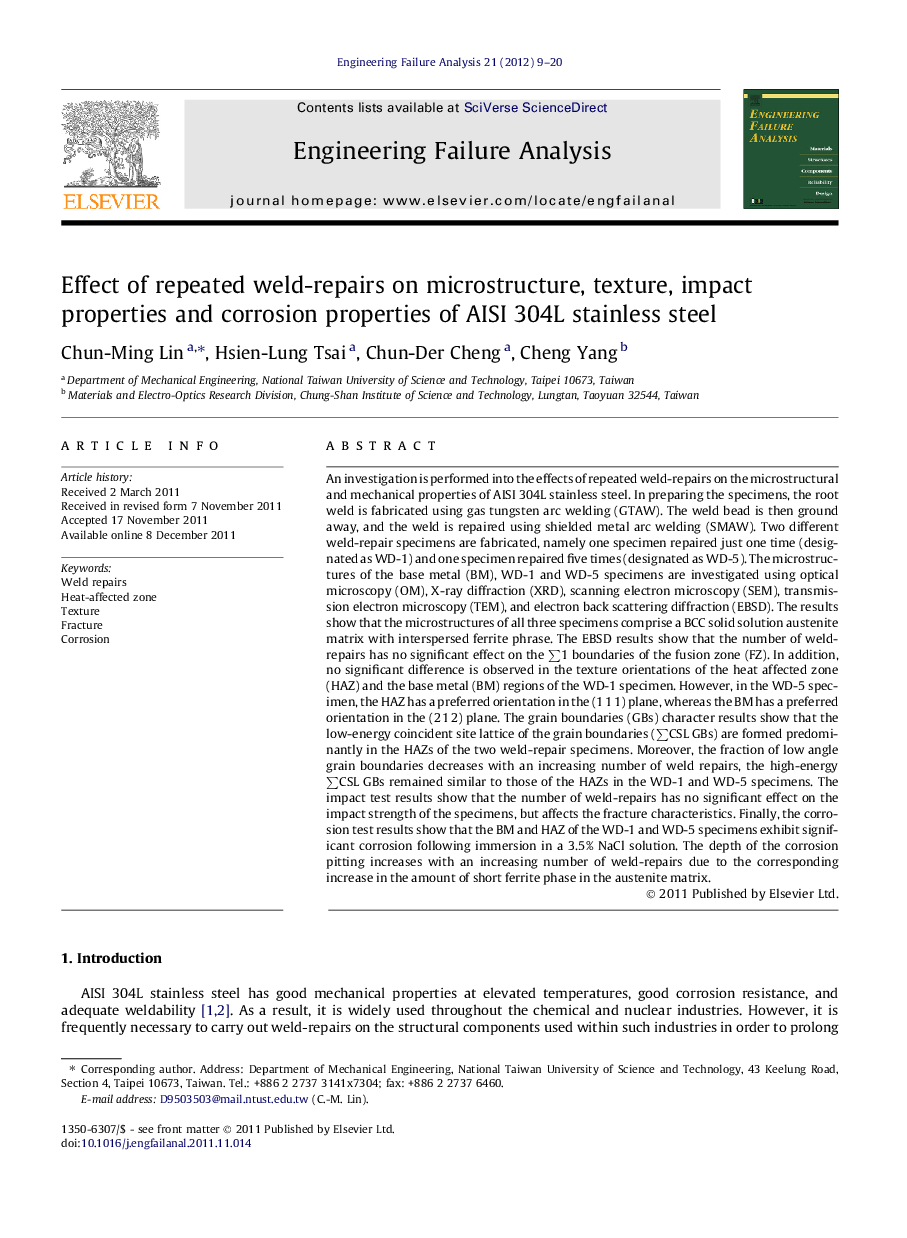| کد مقاله | کد نشریه | سال انتشار | مقاله انگلیسی | نسخه تمام متن |
|---|---|---|---|---|
| 768735 | 1463003 | 2012 | 12 صفحه PDF | دانلود رایگان |

An investigation is performed into the effects of repeated weld-repairs on the microstructural and mechanical properties of AISI 304L stainless steel. In preparing the specimens, the root weld is fabricated using gas tungsten arc welding (GTAW). The weld bead is then ground away, and the weld is repaired using shielded metal arc welding (SMAW). Two different weld-repair specimens are fabricated, namely one specimen repaired just one time (designated as WD-1) and one specimen repaired five times (designated as WD-5). The microstructures of the base metal (BM), WD-1 and WD-5 specimens are investigated using optical microscopy (OM), X-ray diffraction (XRD), scanning electron microscopy (SEM), transmission electron microscopy (TEM), and electron back scattering diffraction (EBSD). The results show that the microstructures of all three specimens comprise a BCC solid solution austenite matrix with interspersed ferrite phrase. The EBSD results show that the number of weld-repairs has no significant effect on the ∑1 boundaries of the fusion zone (FZ). In addition, no significant difference is observed in the texture orientations of the heat affected zone (HAZ) and the base metal (BM) regions of the WD-1 specimen. However, in the WD-5 specimen, the HAZ has a preferred orientation in the (1 1 1) plane, whereas the BM has a preferred orientation in the (2 1 2) plane. The grain boundaries (GBs) character results show that the low-energy coincident site lattice of the grain boundaries (∑CSL GBs) are formed predominantly in the HAZs of the two weld-repair specimens. Moreover, the fraction of low angle grain boundaries decreases with an increasing number of weld repairs, the high-energy ∑CSL GBs remained similar to those of the HAZs in the WD-1 and WD-5 specimens. The impact test results show that the number of weld-repairs has no significant effect on the impact strength of the specimens, but affects the fracture characteristics. Finally, the corrosion test results show that the BM and HAZ of the WD-1 and WD-5 specimens exhibit significant corrosion following immersion in a 3.5% NaCl solution. The depth of the corrosion pitting increases with an increasing number of weld-repairs due to the corresponding increase in the amount of short ferrite phase in the austenite matrix.
TEM microstructures of AISI 304L stainless steel specimens: (a) BM, (b) HAZ of WD-1, (c) HAZ of WD-5; (d) SAD pattern of austenite matrix, and (e) SAD pattern of ferrite phase. Texture inverse pole figures of BM, WD-1, and WD-5.Figure optionsDownload as PowerPoint slideHighlights
► Microstructural and properties evolution of repeated weld-repairs were studied.
► Microstructures of BM and two weld-repair specimens has austenite and ferrite phase.
► Repeated weld-repairs induce a transformation of the ferrite phase within the matrix.
► Mechanical property induces the number of weld-repairs has no significant effect.
► Corrosion property of HAZ of the WD-5 specimen are significantly.
Journal: Engineering Failure Analysis - Volume 21, April 2012, Pages 9–20